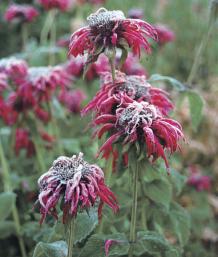
Photo/Illustration: Amy Hinman
The first year I gardened in Montana, it snowed on August 21. That’s when I realized this Ohio gardener had a lot to learn about a cold and unpredictable climate. Yet my new neighbors weren’t much help. As I carted around rock and trucked in topsoil to build raised beds, all they said was, “I’ve lived here for 20 years and can’t grow a thing.” Fortunately, listening has never been one of my strong points.
Not one to be deterred, I’ve rushed outside in the middle of the night as temperatures plummeted to cover dozens of raised beds. And it’s at just such moments that I’ve questioned my own sanity. While USDA Hardiness Zone 3 (where winter temperatures can dip as low as –40°F) is not especially conducive to growing heat-loving plants, it has provided me with an opportunity to learn how to make the most of a short growing season and to extend that season as long as possible.
Start with tough perennials
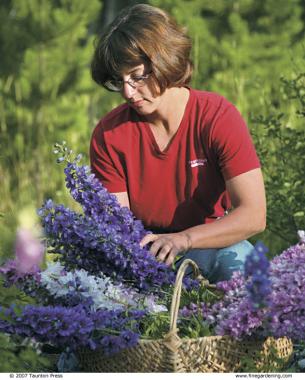
The first secret to gardening in a cold climate is to grow really hardy perennials, and there are a number of plants that are troopers no matter how harsh the winter or spring. As a general rule, those that die back to the ground each fall do better than evergreen perennials, although I have successfully overwintered both lavender (Lavandula angustifolia ‘Munstead’) and sage (Salvia officinalis).
The first plant to force its way through the last of the snow is perennial cornflower (Centaurea montana). It often blooms by the beginning of May, when I am in desperate need of some color. After it flowers, I cut it back by two-thirds and it blooms again by the end of summer. Another early riser is oregano (Origanum vulgare), which I grow not only for its use in the kitchen, but also for the flowers it produces. Artemisias (Artemisia ludoviciana ‘Silver King’ and ‘Silver Queen’) poke through the soil much later, but are consistent every year, along with other herbs like valerian (Valeriana officinalis), bee balm (Monarda didyma), and anise hyssop (Agastache foeniculum). These tough plants will continue blooming through an unexpected mid-summer frost (photo, above).
Domesticated varieties of wildflowers (which I prefer for their showier blossoms) also do well. Lupines (Lupinus cvs.) are early summer bloomers that generously reseed themselves. Delphinium cultivars—6-foot giants compared to their cousin, the native larkspur—love the cool temperatures and pull through most winters without a problem (photo, above). Their biggest enemies are the wind and hail that often accompany summer thunderstorms. To keep these delphiniums from being blown over, I stake them, plant them near buildings, and grow the shorter varieties.
Peonies (Paeonia cvs.), bearded irises (Iris cvs.), sneezewort (Achillea ptarmica ‘The Pearl’), sea holly (Eryngium maritimum), and tansy (Tanacetum vulgare) are also sound choices for tough climates. I never worry about their surviving, and they produce fantastic flowers every year.
Fill in with cool-season annuals
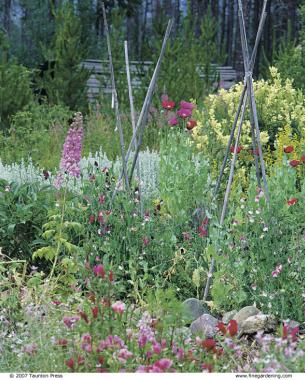
I love annuals for their bright color and the distinct personality they add to the garden in summer. I start thousands in my greenhouse each year, sowing them in early March for blooms by mid-July. I look mostly for fabulous color and fragrance, but I’ve also discovered many that are cold tolerant. By experimenting (and sacrificing many plants), I’ve found varieties that will even withstand light frost.
Stock (Matthiola spp.), an annual featuring spikes of flowers with a spicy, carnationlike fragrance, is one I can set out knowing it will withstand subfreezing temperatures. It might not be happy to have its leaves frostbitten, but I’ve never lost it to a late cold snap. Evening-scented stock (Matthiola longipetala ssp. bicornis), a knockout in the fragrance department, often reseeds profusely. Clarkia species and annual poppies (Papaver somniferum) also selfsow from year to year in my garden, adding drifts of color here and there.
Through the years, I’ve found that when these self-sown annuals are about 3 inches tall, it’s usually safe to transplant the annuals I’ve started in the greenhouse and hardened off. If we have a heavy frost, the leaves of transplants often turn reddish in color, but they usually survive. Those that come up on their own tend to show less stress. One thing to keep in mind when growing annuals from seed is how long it takes them to produce flowers from the time of germination. In my garden, those that take 120 days don’t bloom until the end of the season, if at all, so I look for annuals that flower sooner.
Many biennials, which have a twoyear life cycle, are also good choices for cold climates. I started parent plants of foxglove (Digitalis purpurea), sweet William (Dianthus barbatus), and hollyhock (Alcea rosea) in the greenhouse for three years in a row and then let them self-perpetuate in the garden. I’ve found that they are easy to transplant if they don’t sprout where I want them.
Tough plants for cold climates
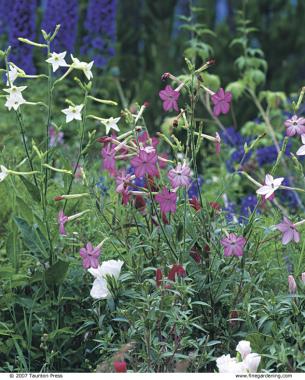
Perennials
Anise hyssop (Agastache foeniculum)
Artemisias (Artemisia ludoviciana ‘Silver King’ and ‘Silver Queen’)
Bearded irises (Iris cvs.)
Bee balm (Monarda didyma)
Delphinium cvs.
Hops (Humulus lupulus)
Lavender (Lavandula angustifolia ‘Munstead’)
Lilies (Lilium spp.)
Lupines (Lupinus cvs.)
Oregano (Origanum vulgare)
Peonies (Paeonia cvs.)
Perennial cornflower (Centaurea montana)
Sage (Salvia officinalis)
Sea holly (Eryngium maritimum)
Sneezewort (Achillea ptarmica)
Tansy (Tanacetum vulgare)
Valerian (Valeriana officinalis)
Yarrow (Achillea millefolium)
Annuals, biennials, tender perennials
Key to annuals and biennials: 1 = frost tolerant, 2 = reseeds, 3 = short time to maturity
Clarkia spp. 1, 2, 3
Flowering tobacco (Nicotiana sylvestris) 1, 2
Foxglove (Digitalis purpurea) 1, 2
Hollyhock (Alcea rosea) 1, 2
Lobelia (Lobelia erinus) 3
Pincushion flower (Scabiosa atropurpurea) 1
Poppies (Papaver somniferum) 2, 3
Snapdragon (Antirrhinum majus)
Stock (Matthiola spp.) 1
Strawflowers (Bracteantha bracteatum) 1
Sweet alyssum (Lobularia maritima) 1, 3
Sweet William (Dianthus barbatus) 1, 2
Tall verbena (Verbena bonariensis) 1, 2, 3
Raised beds and row covers extend the season
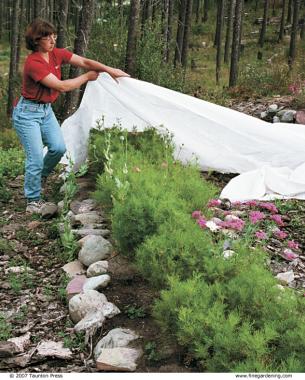
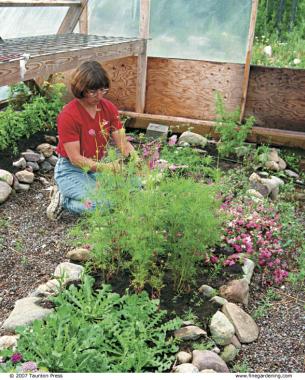
Instead of tilling the earth each spring, I garden in raised beds built from native stone. Although they are raised only 6 to 8 inches, these beds warm up earlier, and their soil dries faster than surrounding ground, which remains cold and water-logged from melting snow.
For transplants or tender annuals that could be nipped by frost, I use floating row covers for protection. The fabric is light and breathable, so it can stay on throughout June. I’ll often cover up plants again late in the season if they are still flowering when a killing frost is forecast.
And finally, I make the most of my greenhouse space. I plant heat-loving tomatoes, peppers, and nasturtiums (Tropaeolum majus), along with later-blooming annuals like Cosmos bipinnatus and Nicotiana sylvestris, in several indoor beds after hundreds of flats of seedlings have been moved to the garden (photo above, on right). When the weather is warm, I leave the doors open, but by August, I close the greenhouse to hold in the heat. It’s a little extra effort at the end of an intense season, but it’s worth it to enjoy the flowers just a little while longer.


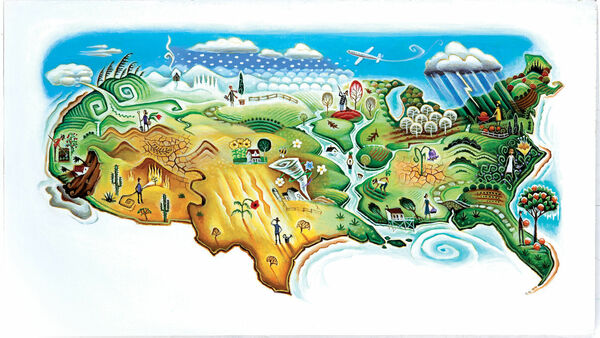
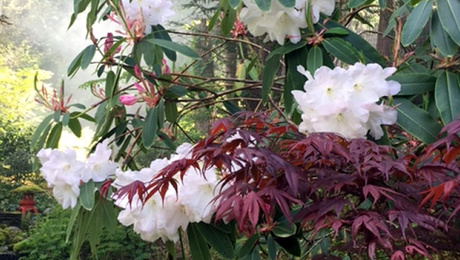
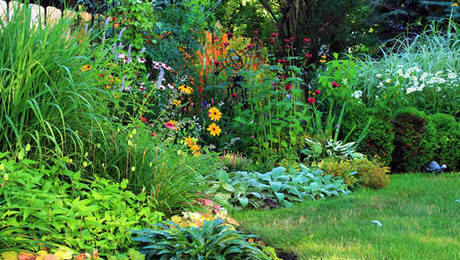
















Comments
Spit and spirit is the antidote to common wisdom...Love your blog.
This freezing thing is something new to me too. I never even closed the windows or turned the heat on in California. I'm not that far south of you in White Sulphur Springs. I'm disabled so it's taking me a while to get my garden going. Just putting in plants for hummingbirds, bees, and butterflies right now. I also had tall weeds last year which are required to be cut. Last year just as we got the first snow, I tossed clover, alfalfa, and rye seeds out. I don't seem to have the tall weeds, but the rye and alfalfa are still going to need cutting. I am going to toss clover seeds about every time I trim and before it snows. It should prevent the taller stuff growing in. How easy is that?!
I found this page because some page said I could grow Alyssum here. I would love to, but I didn't think it would do. But I like to try rather than listen to other folks. Besides, it's getting warmer.
Thank you for your page. Hope your garden is doing well. I'm going to see if you are on Facebook.
Thanks for all the list of plants that do well here in the north (Michigan) I recently moved up from Georgia. The first thing I did was take the Master Gardeners course here. Learned allot but still it was lacking the personal gardeners touch...ya know the kind, where you swap plants and trapes through each others garden...oooing and ahhhing. I have started a pollinates garden (using it as a cut garden as well) and thanks to your list I will be adding a few more to it.
I was jealous of zone 7/8 until I read your article. I live in Boston, zone 6. I see plants that I always want but are usually zone 7. I’m not a novice gardener, like you. What are your thoughts on growing plants that are border line to your growing zone?
I do Cana lilies because I can overwinter them. However, non-bulb perennials tend to make me nervous so I just don’t bother.
I would love to hear your suggestion or advice.
Log in or create an account to post a comment.
Sign up Log in